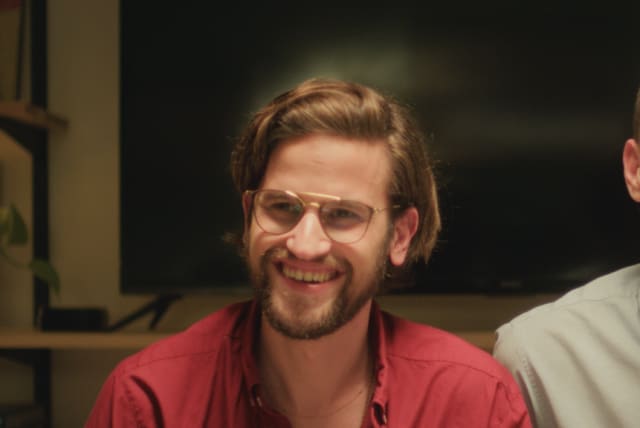Israeli drama film ‘Concerned Citizen’ tackles gentrification and race issues in Tel Aviv

Director Idan Haguel discusses the focus and intention of his film as well as his inspirations for it.
The Israeli satirical drama film “Concerned Citizen” opens with the sacrosanct rituals of a bourgeois Tel Aviv life: a robot vacuum slides gracefully across the floor; lush house plants are watered; vegetables are blended into green juice. The score from the Bellini opera “Norma” plays in the background.
Then a car alarm rudely interrupts the utopia.
It only gets worse from here for Ben and Raz, a progressive Israeli gay couple (played by actors Shlomi Bertonov and Ariel Wolf, who are also a couple in real life) living in a pristine renovated apartment in a gentrifying neighborhood in south Tel Aviv. When Ben, a landscape architect, plants a tree on their block, his seemingly innocent desire to improve the neighborhood quickly goes awry, and a series of events forces him to face his own repressed prejudices and hypocrisy.
With the tension of a thriller, “Concerned Citizen,” the second feature film by Israeli writer-director Idan Haguel, tackles the universal themes of privilege and multicultural tension in gentrifying cities, using the hyper-specific lens of Naveh Sha’anan — the south Tel Aviv neighborhood that’s home to many of the country’s foreign workers and asylum seekers, as well as the city’s notoriously rundown (but culturally vibrant) Central Bus Station.
After making its world premiere last year at the famed Berlin International Film Festival, the movie debuts in select US theaters on Friday and will also be available to rent on Amazon and Apple TV+.
Ben and Raz’s apartment, a hot commodity in one of the world’s most expensive cities, is the axis around which much of the drama revolves. In one scene, a French-Jewish woman looks into buying the apartment sight unseen. Their neighbors include both the extremely vulnerable and the privileged: immigrants from Eritrea in one apartment, and a writer plotting his move to Berlin with his foreign wife in another.
Idan Haguel spoke with the Jewish Telegraphic Agency about the film and his personal connections to it. After losing his suitcase, Haguel chatted on his phone from a cafe in Berlin before heading to New York for the film’s American release.
This conversation has been edited and condensed.
The interview
JTA: Tell me a little about yourself and how you became a filmmaker.
IH: I was born in the suburban city Rishon LeTsiyon and I always didn’t know what to do with my life. After the army I decided to go to film school. I wanted to be a scriptwriter, to do comedies. I discovered filmmaking, directing, and I gradually fell in love with that part. Then after school, I became a journalist because I couldn’t make a film — it was very difficult for me to get into that world. When my journalism career ended abruptly by the closing of the magazine, I decided that it’s now or never. I made my first feature film, that was a film called “Inertia.” That film is based on childhood memories of my grandparents. My grandparents were immigrants from Lebanon, Romania and Thessaloniki in Greece.
“Concerned Citizen” is partially about immigration. Why was it important to you to focus on the immigrant experience?
I was drawn into the irony, and, some may say, hypocrisy of living in a country that historically was formed by the narrative of [the Jew] being the immigrant of the world, not accepted into other countries, that in some ways still holding that grudge against countries that weren’t receptive to the immigrant Jew and pushed immigrants out. Of course, there is the horror story of Germany and the Holocaust and that’s the extreme end of mistreating “the other.” So living in a country formed by immigrants, [contrasted with] the way we behave to immigrants who are not part of the ethos of the Jewish immigrant narrative — I was drawn into that irony, although it wasn’t an intellectual process. It was more based on the experience of living in that neighborhood in south Tel Aviv, being marinated in the dilemmas and the daily complexity of living in Naveh Sha’anan as a bourgeois, middle class person. After a few years I wanted to comment on that. I wanted to be brutally honest with myself and about myself. So my daily life and the life of my neighbors and friends became the material with which I wrote this fictional movie.
And you shot the film in your old apartment!
That was the mindfuck of the whole production, because I made the story close to me but I left a distance. I used my experience but I created these characters who are very close but very different. I shot the therapy scenes in my therapist’s clinic. I shot the building scenes in my building on my street. Everything became very, very close and it was really an “Alice in Wonderland” experience. Looking into a mirror and everything is morphing and making you look different and look differently at yourself and your life.
Can you talk about the south Tel Aviv neighborhood where the film is set, Naveh Sha’anan?
It’s the outskirts of the center of Tel Aviv. It was always an immigrant neighborhood. But it changed over the years, it became working immigrants. In the 90s, there were the Romanian immigrants, and then it was Chinese immigrants who came to work in Israel. And over the last 15 years it has become immigrants from Africa, combined with older people who have lived there years and new people who are the more gentrifiers of the neighborhood, artists and gay people and those who are more economically stable. So now the neighborhood is comprised of sex workers, immigrants, junkies, dealers, and gay people. It’s a mix, but the prices have gone low, and people who didn’t have enough money to buy property in the city center started buying there. So the neighborhood has this tension of people who want to live a more bourgeois life, but they’re in the middle of the neighborhood with people who don’t have rights, who are immigrants, who don’t know if tomorrow the government will kick them out. People from all over the world. But it’s become a haven for investors and the neighborhood is in the middle of being gentrified and changed.
So it’s a very interesting setting to live in and to make a film in. It’s very dense. It’s one of the less homogenic and more diverse areas in Israel. Israel prides itself on the diversity of Jewish people coming from Arab countries, coming from Europe. But they’re all Jewish and they share a common mentality and they’re all citizens of Israel. Naveh Sha’anan is more diverse – it’s people from India, China, Eritrea, Sudan, the Ivory Coast. I feel it’s a missed opportunity by Israeli society that instead of accepting these people legally and into our society, they are trying to hold back and fight against it. It’s also very ironic that Israel is becoming a state that aspires to have a government like this. It’s mind-boggling. It’s like, we learned nothing from history and our own history. It’s like people don’t want to connect dots. They just want to see the cruel history that they experienced as the Jewish people and feel like it was something personal that happened to them, and like they cannot be the victimizers at all.
You’ve said that this film is very much about the idea of who’s the victim and who’s the victimizer.
When you raise yourself and your children on the narrative of being a victim and perpetuating historical trauma, it’s very hard to notice other people’s traumas, and the fact that you are creating traumas for other people. Because you’re constantly in trauma and you’re always dealing with your own trauma and you’re always the victim and you’re the center of the world, but you are not the center of the world. I think it should change. But no one cares what I think! Sometimes I don’t care about what I think.
What was the casting process like?
The casting process was through meeting people and going to plays. [I turned to] the Holot theater company to cast the Eritrean community in Israel. It was cast mainly by meeting actors from the group, having conversations with them. Basically they wanted to participate in the film and I was very lucky about that. They’re a group that used to be based in Holot outside of a temporary incarceration open prison for immigrants who don’t have permits to stay in Israel. They put them in an open prison in the desert close to the Negev.
There’s an interesting scene between the French-Jewish woman (played by Flora Bloch) who is trying to move to Israel and Ben that I thought was a very revealing moment about the ways that Jewishness is expressed when Jews are a minority in the country versus when they are the majority in the country. The French woman is concerned by France’s antisemitism and wants to move to Israel, while Ben is tortured by the complexities of living as a privileged Jewish Israeli person. Can you say something about what that scene meant to you?
One of the things I’m proud about this film is that I feel like it deals with subjects which are not easy subjects to address. But I think we managed to create a balance between comedy and drama that I’m very proud of. I think it allows the film to be self explanatory. It can reveal its deep themes and make you think, in an entertaining way. Again, it’s about irony. It’s about hypocrisy. It’s about human nature. Knowing how to experience your own point of view, and being unable to be in another person’s point of view. It’s human nature, and it’s ever-fascinating to me.
And it also happens to me a lot of times with the fact that I can be in my own shoes and identify my own narrative so much but it’s hard for me to even experience a person who is experiencing the same thing as me but in a different language in different settings. But the resemblance is there so it’s very ironic. And I think that scene is about that.
Jerusalem Post Store
`; document.getElementById("linkPremium").innerHTML = cont; var divWithLink = document.getElementById("premium-link"); if (divWithLink !== null && divWithLink !== 'undefined') { divWithLink.style.border = "solid 1px #cb0f3e"; divWithLink.style.textAlign = "center"; divWithLink.style.marginBottom = "15px"; divWithLink.style.marginTop = "15px"; divWithLink.style.width = "100%"; divWithLink.style.backgroundColor = "#122952"; divWithLink.style.color = "#ffffff"; divWithLink.style.lineHeight = "1.5"; } } (function (v, i) { });

